Revolutionizing transport: optimizing bio and synthetic fuel blends for zero-emission vehicles
Written by Tim Franken and Fabian Mauß
23 August 2023 · 10 min read

The transition of the transport and mobility sector towards zero-emissions and high efficiency is an overarching goal for the economy and society in Europe. With concerns about climate change and air pollution, there is a growing need to reduce greenhouse gas emissions and improve air quality. One major challenge in achieving this goal is the prevalence of internal combustion engines (ICE) as the main propulsion system for millions of vehicles across European countries. While electric vehicles are gaining popularity, the reality is that there are still a significant number of existing ICE vehicles on the road. Therefore, finding medium-term solutions to enhance gasoline ICE efficiency and reduce emissions is crucial.
One approach to improve ICE efficiency is operating it under lean conditions. Traditionally, gasoline engines have been operated with just enough air to completely burn the fuel. However, operating the engine under lean conditions, where there is more air than required for complete combustion, can lead to improved fuel economy and reduced emissions. In this context, scientific and economic stakeholders propose replacing fossil fuels with bio and synthetic fuels to enhance lean-burn capabilities.
New generation of spark ignition fuels to reduce vehicle emissions
A new generation of spark ignition fuels like anisole and cyclopentanone has emerged, offering promising advancements in the automotive industry. These fuels are designed to enhance engine performance, improve fuel efficiency, and reduce emissions. In particular, the partially oxidized state of anisole and cyclopentanone enhances the laminar flame speed (SL) in premixed flames especially under lean operating conditions. Lean operating conditions are investigated for future ICE operation because of the significantly reduced nitrogen oxide (NOx), unburnt hydrocarbon (HC) and carbon monoxide (CO) emissions.
Further, positive aspects of anisole and cyclopentanone are the increased Research Octane Number (RON) and Motored Octane Number (MON) compared to gasoline (RON95 E10). Fuels with RON and MON higher than 100 are considered as knock-resistant. Knock is an auto-ignition of the unburned fuel after spark ignition accompanied by an acoustic wave which induces a strong pressure peak which potentially can damage the engine. This allows engines to operate at higher compression ratios, resulting in improved efficiency and power output.
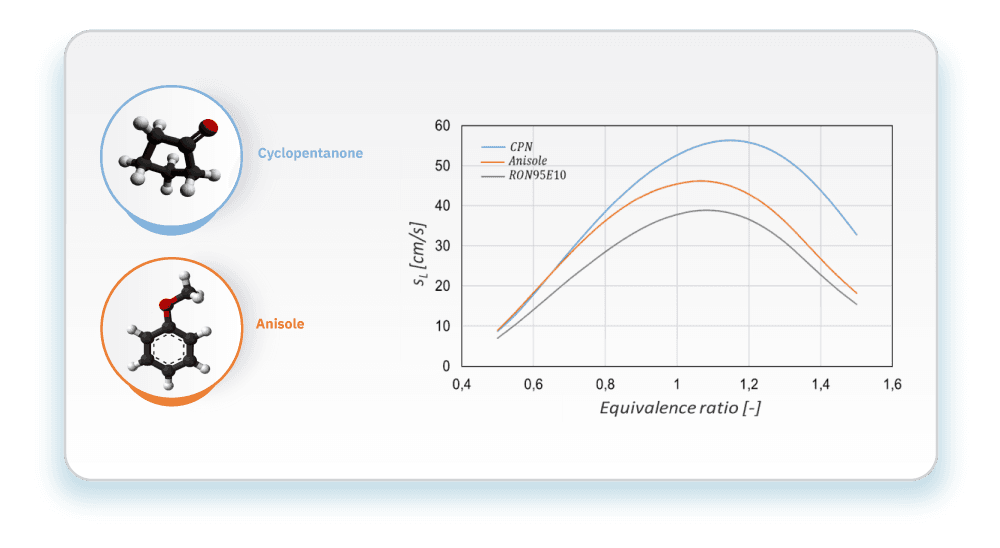
Anisole and cyclopentanone show higher burning velocities compared to RON95E10.
However, the use of anisole and cyclopentanone does pose some challenges for efficient engine operation due to the lower heating value, increased heat of vaporization, and higher boiling temperatures compared to gasoline.
At this point, the following questions arise: How can we evaluate these new fuels? How can we do some kind of fuel and engine optimization since we expect that these fuels perform differently? How can we then adjust the engine?
Engine and fuel co-optimization framework
To reach the overall goal of improving efficiency and engine out emissions, we adopted a computer model capable of predicting the physical and chemical processes of engines for different operating conditions and fuel blends (gasoline, cyclopentanone, anisole). The choice of anisole and cyclopentanone is based on their higher burn rates and higher octane ratings compared to gasoline. Specifically, the project included the following steps:
- Develop a zero-dimensional stochastic reactor model (SI-SRM) for the single-cylinder spark-ignition research engine using LOGEengine (a real time simulation tool specifically designed for analysis and development of internal combustion engines).
- Apply a detailed reaction mechanism (provided by ITV chair of RWTH Aachen) for gasoline, anisole and cyclopentanone to be able to predict laminar burning velocity, ignition delay time and emission formation for different operating conditions (The detailed reaction mechanism consists of hundreds of chemical species and thousands of elemental reactions describing the oxidation of the fuel. Further, it includes the data to calculate the thermodynamic and transport properties of the chemical species).
- Develop the dual-fuel tabulated chemistry models for gasoline-anisole and gasoline-cyclopentanone blends using LOGEtable (An intuitive and user-friendly chemistry table generator).
- Create a multi-objective optimization framework in modeFRONTIER, process automation and design optimization software, by including the zero-dimensional stochastic reactor model (SI-SRM) and the detailed reaction mechanism.
The engine and fuel co-optimization framework is a powerful approach to evaluate these new generation fuels. The framework comprises quasi-dimensional engine and tabulated chemistry models to predict the thermochemical processes in spark ignition engines. By employing genetic optimization algorithms, we wanted to find a set of design solutions with improved efficiency and reduced emissions under a given set of parameters. After that, we applied Multi-Criteria Decision Making (MCDM) technique to choose the best designs with better engine operating conditions for these new alternative fuel blends.
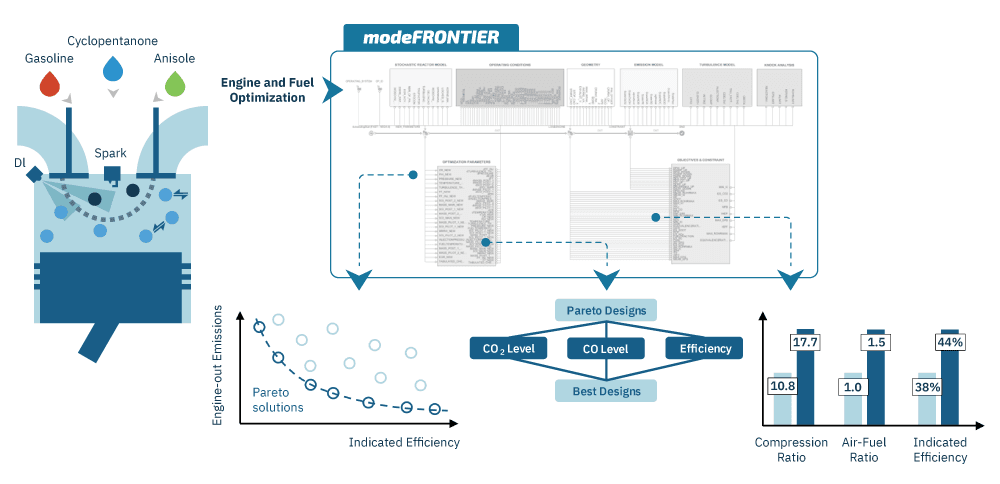
Engine and Fuel Co-Optimization framework using the Stochastic Reactor Model with Tabulated Chemistry
In modeFRONTIER, the multi-objective optimization framework is divided into two levels (“main project” and “sub project”). The Design of Experiments (DOE) was run on top of the "main project". Stochastic reactor model, turbulence model, geometry, operating conditions, emissions model, knock analysis were used as input variables to define different operating points. Then, we considered only the input variables of two subsystems (geometry and operating conditions) for engine and fuel co-optimization.
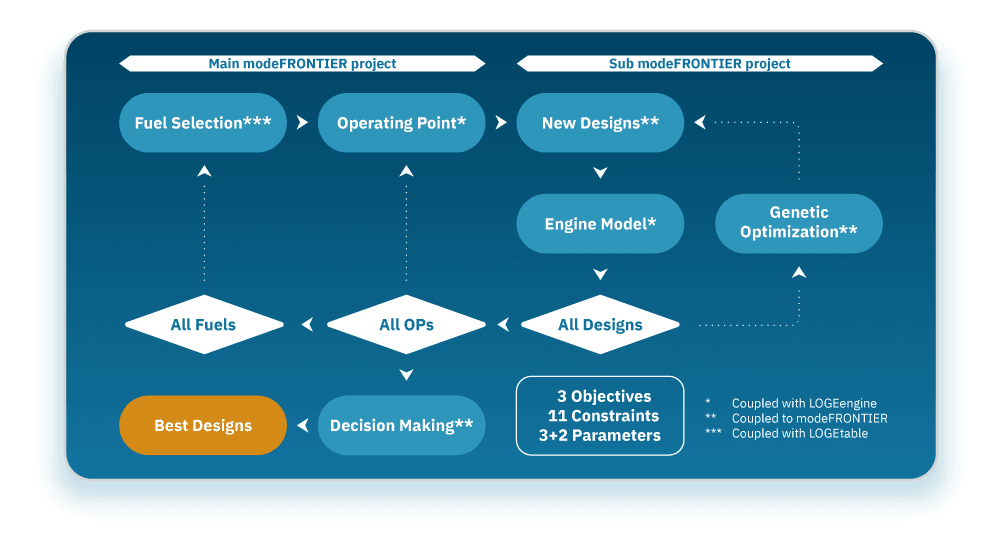
Next, the input variables from the "main project" were passed to the "sub project" to carry out the optimization task:
- Optimization parameters (share of injected fuel mass, initial cylinder pressure, spark timing, compression ratio).
- Optimization fuel blends (net components and four fuel blends of gasoline-anisole and gasoline-cyclopentanone).
- Constraints (indicated mean effective pressure, fuel air ratio, combustion efficiency, resonance and reactivity parameters, indicated specific fuel consumption, energy specific CO2 and CO engine-out emissions) are set to force the optimization algorithm to search only within a specific region of the engine operation map.
- Three objectives: maximize indicated efficiency; minimize energy specific CO2 engine-out emissions; minimize energy specific CO engine-out emissions.
For the optimization run, the FAST Non-dominated Sorting Genetic Algorithm II (NSGA-II) has been used to evaluate 3000 designs.
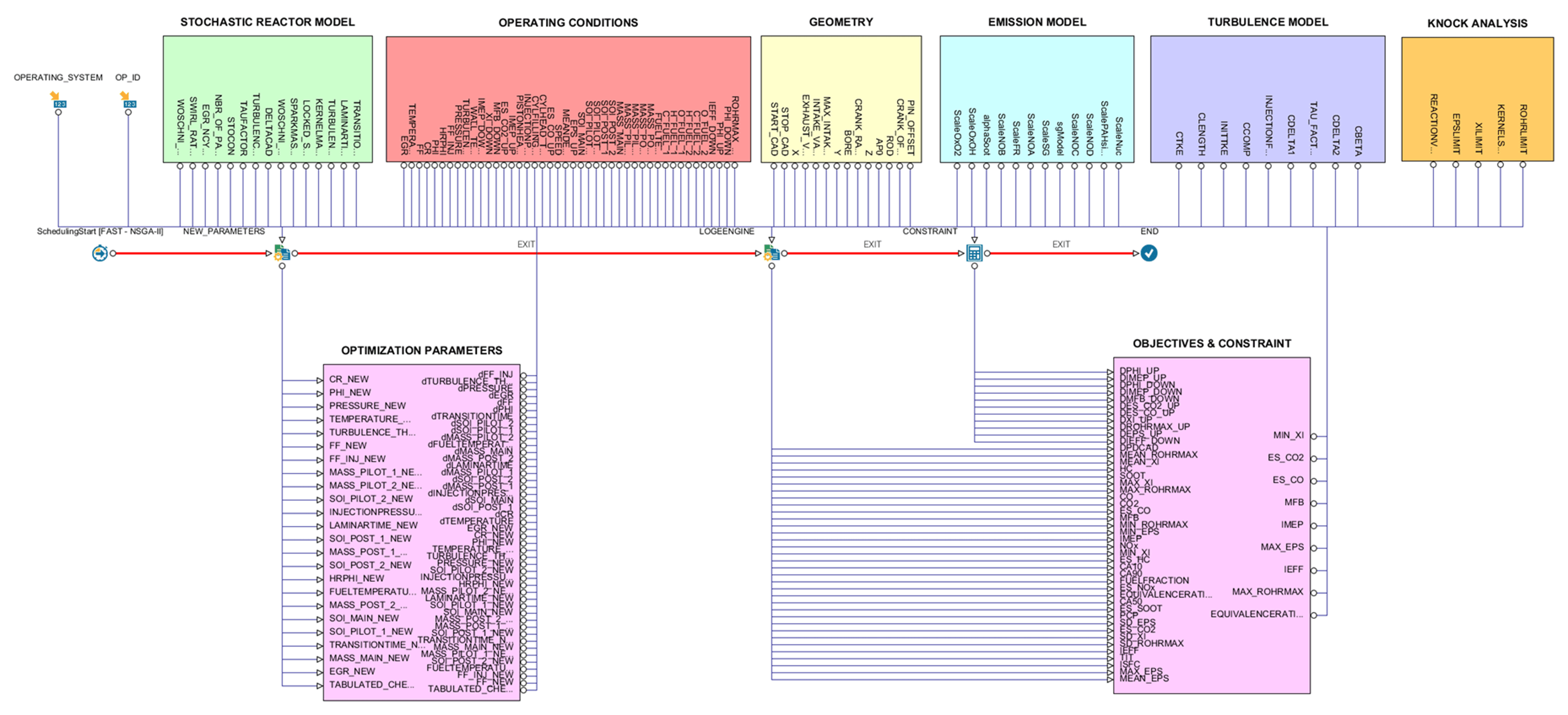
The main project (upper) and sub-project (lower) in the modeFRONTIER simulation workflow.
Optimization shows pathways to achieve lower engine-out emissions and higher indicated efficiency
We applied Multi-Criteria Decision Making (MCDM) technique to choose the best designs with better engine operating conditions for the different fuel blends and different compression ratios. The high C:H ratio of anisole leads to an increase of the specific CO2 emissions compared to the other fuel blends. Cyclopentanone is generally showing lower sCO2 and higher indicated efficiency compared to anisole, also as a blend with RON95E10. The increase of the compression ratio from 10.8 to 13.5 further shows a reduction of sCO2 emissions and increase of indicated efficiency. The optimized RON95E10 case shows the best results since anisole and cyclopentanone have a lower heating value. For this reason, they are less efficient compared to gasoline. However, anisole and cyclopentanone have much higher RON / MON compared to gasoline. As a result, they can be operated at more efficient conditions in the low-end torque operating range.
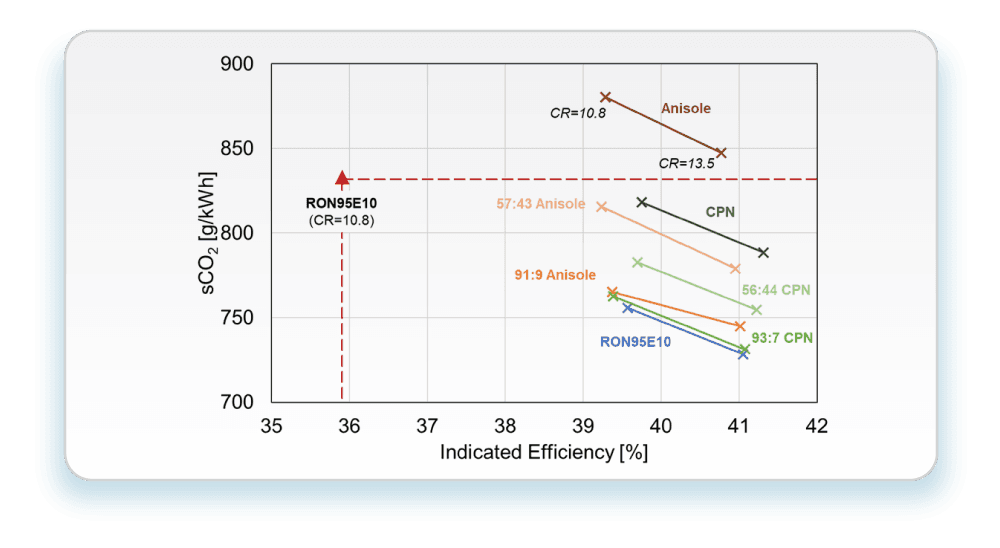
Efficiency vs. sCO2 engine-out emissions for RON95E10 - anisole and RON95E10 – cyclopentanone (CPN) blends
The optimized cases showed a significantly reduced specific NOx engine-out emission compared to the base case. The reason is with the much lower equivalence ratio, less NOx is formed during combustion and the engine can be operated at more efficient conditions. The higher laminar flame speed of anisole and cyclopentanone at lean conditions further supports a stable combustion.
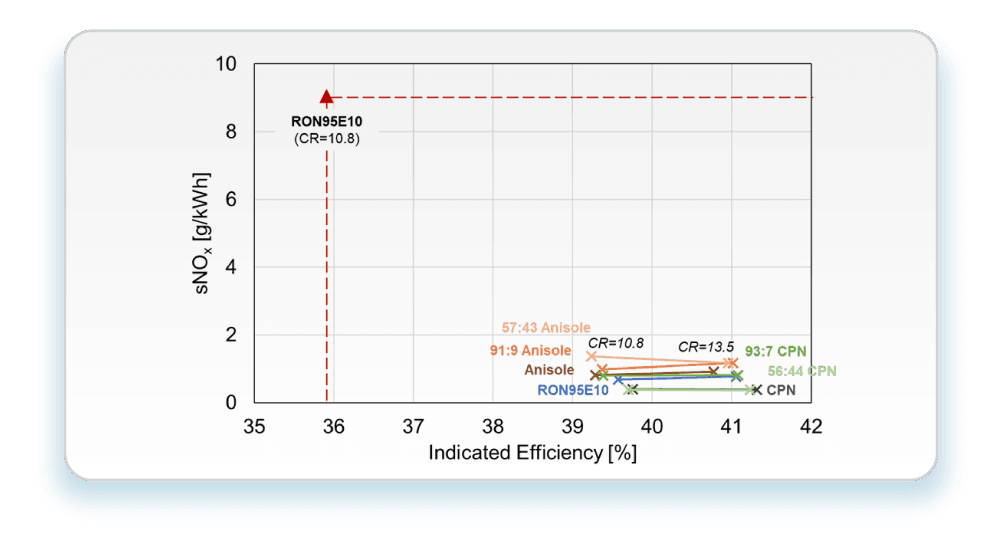
Efficiency vs. sNOx engine-out emissions for RON95E10 - anisole and RON95E10 – cyclopentanone (CPN) blends
The objective of this project was to develop a multi-objective optimization framework that integrates a quasi-dimensional stochastic reactor model with detailed chemistry in order to efficiently conduct predictive evaluations of various fuel blends. An RSM-based genetic algorithm (FAST NSGA-II) available in modeFRONTIER was utilized to approximate the Pareto solutions.
modeFRONTIER is a powerful tool to automate complex workflows and easily integrate different software codes. The available optimization algorithms are robust and efficient to find optimum solutions even for highly stochastic problems.
A total of 3000 designs were evaluated for each combination of operating condition and fuel blend. From this extensive evaluation, the best designs were systematically selected from the Pareto solutions using a linear multi-criteria decision-making algorithm. Ultimately, it was found that both neat cyclopentanone and cyclopentanone-RON95E10 blends showed the most remarkable performance in terms of thermal efficiency and CO2 emissions.
This work is conducted within the Forschungsvereinigung Verbrennungskraftmaschinen (FVV) research project (No. 601348) and was funded by the FVV from own resources and supervised by an expert group under the direction of Nozomi Yokoo and Dr. Yoshihiro Okada. The authors gratefully acknowledge the support received from the research Association for Combustion Engines (FVV) e.V. and from all project participants.
Since 2006 Prof. Dr.-Ing. Fabian Mauß is head of the chair of thermodynamics and thermal process engineering at BTU Cottbus-Senftenberg. His research group develops detailed kinetic models for gas phase and surface chemistry for technical combustion applications. The chemistry models are applied to optimize the performance of internal combustion engines and exhaust aftertreatment systems. In 2021 he was appointed as Fellow of the Combustion Insitute, the main institution in the field of combustion science and technology.
Since 2006 Prof. Dr.-Ing. Fabian Mauß is head of the chair of thermodynamics and thermal process engineering at BTU Cottbus-Senftenberg. His research group develops detailed kinetic models for gas phase and surface chemistry for technical combustion applications. The chemistry models are applied to optimize the performance of internal combustion engines and exhaust aftertreatment systems. In 2021 he was appointed as Fellow of the Combustion Insitute, the main institution in the field of combustion science and technology.
modeFRONTIER is the leading software solution for simulation process automation and design optimization
Design better products faster
modeFRONTIER is the leading software solution for simulation process automation and design optimization
Design better products faster
modeFRONTIER is the leading software solution for simulation process automation and design optimization


